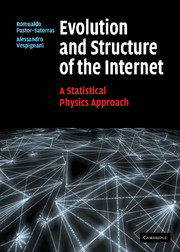Book contents
- Frontmatter
- Contents
- Preface
- List of abbreviations
- 1 A brief history of the Internet
- 2 How the Internet works
- 3 Measuring the global Internet
- 4 The Internet's large-scale topology
- 5 Modeling the Internet
- 6 Internet robustness
- 7 Virtual and social networks in the Internet
- 8 Searching and walking on the Internet
- 9 Epidemics in the Internet
- 10 Beyond the Internet's skeleton: traffic and global performance
- 11 Outlook
- Appendix 1 Graph theory applied to topology analysis
- Appendix 2 Interface resolution and router topology
- Appendix 3 Numerical analysis of heavy tailed distributions
- Appendix 4 Degree correlations
- Appendix 5 Scale-free networks: scaling relations
- Appendix 6 The SIR model of virus propagation
- References
- Index
10 - Beyond the Internet's skeleton: traffic and global performance
Published online by Cambridge University Press: 12 January 2010
- Frontmatter
- Contents
- Preface
- List of abbreviations
- 1 A brief history of the Internet
- 2 How the Internet works
- 3 Measuring the global Internet
- 4 The Internet's large-scale topology
- 5 Modeling the Internet
- 6 Internet robustness
- 7 Virtual and social networks in the Internet
- 8 Searching and walking on the Internet
- 9 Epidemics in the Internet
- 10 Beyond the Internet's skeleton: traffic and global performance
- 11 Outlook
- Appendix 1 Graph theory applied to topology analysis
- Appendix 2 Interface resolution and router topology
- Appendix 3 Numerical analysis of heavy tailed distributions
- Appendix 4 Degree correlations
- Appendix 5 Scale-free networks: scaling relations
- Appendix 6 The SIR model of virus propagation
- References
- Index
Summary
In previous chapters we have presented an X-ray picture of the Internet's topological skeleton and the consequences that the revealed structure has on several properties of this network. There is, however, another dimension to add to the Internet picture that refers to the quantitative characterization of the actual flow of data and transmission capacity of the various elements forming the Internet. Physical links have a large heterogeneity in their data transmission capacity. Also, the traffic load is highly variable on different connections and at different times; that is, a full characterization of the network cannot prescind from the knowledge of the interplay between the topological structure, the detailed physical properties of each element, and the traffic generated by users.
The measurement and modeling of link traffic and performance in LANs or WANs has been a major area of activity over the recent years. These studies pointed out the failure of the Poisson traffic model, providing empirical evidence for traffic self-similarity. The modeling of these properties finds a natural framework in the vast mathematical theory of self-similar stochastic processes, and intense research activity has been focused both on the understanding of the origin of the scale-free nature of traffic and its implications at the performance level. Measurements of link traffic imply the accumulation of very long time series of traffic loads and usually refer to a specific link or very small networks.
- Type
- Chapter
- Information
- Evolution and Structure of the InternetA Statistical Physics Approach, pp. 211 - 225Publisher: Cambridge University PressPrint publication year: 2004



